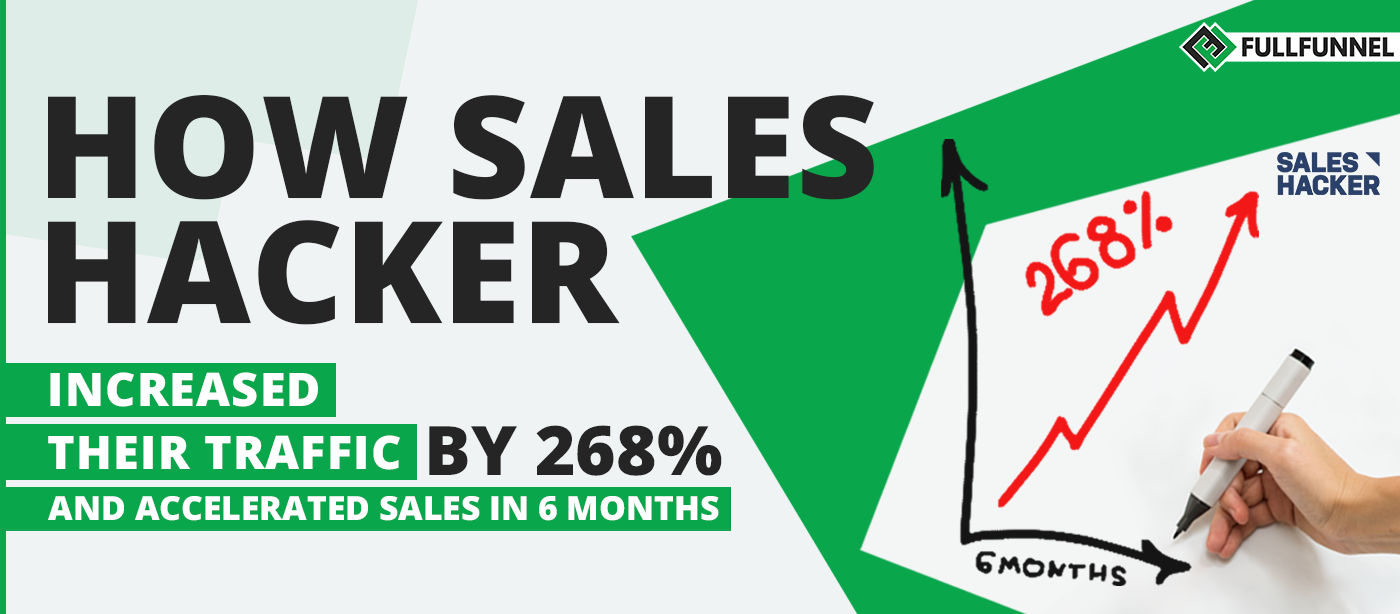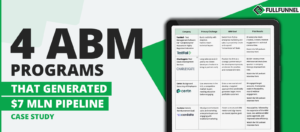Today I’m going to show you a great B2B content marketing case study on:
- How Sales Hacker increased its traffic by 268% from 90.000 monthly visitors to 242.000 in 6 months
- The breakdown of Sales Hacker’s lead generation and lead nurturing approach
- How do they align the marketing and sales team around content marketing
The most interesting fact is that Sales Hacker didn’t increase the marketing budget. They didn’t have lots of social media followers. They didn’t invest heavily in paid ads.
I’ve chatted with Gaetano Di Nardi, ex VP of marketing at Sales Hacker, to share with you the exact process they used.
Table of Contents
ToggleSales Hacker B2B content marketing strategy
First of all, let me underline the fact that we are talking about a highly competitive space. Sales Hacker has strong authoritative competitors such as Hubspot, Marketo, and Salesforce, who were already ranked for most of their target keywords.
Gaetano decided to produce high-quality and highly optimized content for very specific keywords that aren’t difficult to rank for, then produce the best possible content on the topic.
For example, the biggest driver of organic traffic growth was ranking #1 for very targeted keywords such as Sales operations and Sales Skills. These keywords generate Sales Hacker huge quality traffic.
But you’d understand that the increased traffic volume impacted Sales Hacker’s pipeline and revenue indirectly because Sales Hacker doesn’t have a specific product. Their business model is generating high-quality B2B leads for their partners.
That’s why we don’t share any revenue numbers here.
Key Learnings
Here is a list of my key learnings about Sales Hacker’s B2B content marketing strategy.
Sales Hacker content team looks at the content that is already ranked #1 on Google. If they can’t produce 3x-5x better content, they don’t add the topic to their content plan. It takes 3 to 6 months to start ranking for target keywords.
You’d be patient. Don’t try to target keywords that have already been ranked by companies with a strong domain authority (like Hubspot or Salesforce in Sales Hacker’s case). Tips for the companies who are just starting with inbound marketing.
When Gaetano started at Sales Hacker, they already had the engine process, but it was broken a bit, so he just needed to fix it.
If you are a brand new or early-stage startup and want inbound marketing to be a part of your strategy, you need really commit to it. You can’t be one foot in, one foot out.
You also need leads coming fast.
The best way to start inbound marketing is just to hire one person working on it and involve your sales team in outbound lead generation. Don’t ignore outbound and go all-in for inbound. Inbound marketing won’t generate leads quickly, but the compound interest and ROI will be significant over time.
B2B Content marketing metrics that Sales Hacker tracks
The most common question from marketers is what B2B content marketing metrics they should track. Here is a list of Sales Hacker’s metrics.
The North Star metric of their B2B content marketing strategy – email list growth by directors and VPs of marketing.
1. New email subscribers by lead source ( where the most quality leads came from) and unsubscribe by the source of the lead.
Example: Sales Hacker did a co-sponsored event. They got new email subscribers from that event and tried them to double opt-in.
Only a few of them opted-in and most just unsubscribed. This way they evaluate the efficiency of the marketing activity and make decisions about what works for them and what doesn’t work.
2. Overall month list growth by percentage.
Sales Hacker breaks this down by the audience segment. What’s the engagement rate and growth of VPs of sales compared to VPs of marketing? It dictates what they do around content strategy.
3. Campaigns from UTM.
Sales Hacker wants to see the ROI from Facebook ad campaigns, co-marketing events, webinar registrations and attendees, and registration from sources.
4. Weekly newsletter performance.
Here they track overall engagement as open rates, click rates, delivery rate, bounce rate, etc.
5. Month over month organic traffic and organic keyword growth.
Sales Hacker tracks the trajectory for the traffic based on their target keyword positions and volumes.
6. Paid acquisition.
Sales Hacker tracks impressions, clicks, and conversions from FB ads.
B2B lead generation strategy
Sales Hacker lead generation approach is very different from traditional B2B lead generation.
They don’t do any outbound sales: cold calling or cold outreach email. They heavily promote the content from their blog and focus on getting people to sign to the email list.
What really surprised me was that they don’t use at all the most common tool for converting website visitors to subscribers as pop-ups. You’ll never see on Sales Hacker’s website gigantic pop-ups like «Do you want more traffic? No, then you suck at marketing». Even Sales Hacker’s north star metric is email list growth by directors and VPs of marketing, they don’t use pushy methods.
Sales Hacker believes (what became the foundation of their B2B content marketing strategy) that if the content is really good and valuable for the target audience, they’ll decide to signup to the email list anyway.
After people subscribed to Sales Hacker’s email list, they activate and engage with new subscribers with a help of marketing automation. Sales Hacker developed a specific buyer journey and send very specific content to each market segment.
First of all, Sales Hacker sends a welcome email with a video of what Sales Hacker is about, and asks to fill in an enrichment survey.
Survey asks about the specific job roles, departments, business experiences, topics subscribers are interested in, size of the company.
The average response rate is 15% is really good.
If new subscribers don’t fill in the survey, Sales Hacker sends their data to Clearbit and tries to enrich it there.
Every quarter they check the database and add to separate segment subscribers, who weren’t enriched. Then Sales Hacker sends these subscribers again enrichment survey and asks them to fill it in.
The email is very simple «We want to learn more about you and personalize your experience». When the survey (Sales Hacker uses Typeform) is filled in, the information transfers automatically to Active Campaign.
Such enrichment and proper segmentation are critical to Sales Hacker as they host events to very specific audiences and a mass email blast can provoke a huge unsubscribe rate.
At this point, you might ask: what do they do with the subscribers who don’t fit Sales Hacker’s ideal customer profile?
Sales Hacker doesn’t delete them as these subscribers still engage with the content, share it, and recommend Sales Hacker. On the contrary, Sales Hacker tries to nurture and make them the brand advocates.
Sales Hacker has 2 different segments for lead nurturing.
1. Activation for content and engagement.
Before starting to send them any offers, Sales Hacker passes you through drip email series based on your interests. They don’t send any offers like many companies do because this doesn’t work.
Before the subscriber is considered to be activated they need to meet several engagement criteria: complete an onboarding survey, get classified in the database, time bounce – subscribers must be on the list for 90 days and you sign up for a webinar or read the long-form guide for 1m 30 sec.
2. Leads’ qualification for partnership program – B2B SaaS.
1) They go to a partnership program and fill in the form. Sales Hacker has there a questionnaire where leads can be qualified.
2) They can request a meeting with the head of sales via chatbot.
3) They passed Sales Hacker’s content journey and are hyper-engaged – they read lots of content and sign up for several webinars.
Let’s look at the Sales Hacker’s B2B sales funnel.
When the subscriber is activated, the head of sales at Sales Hacker gets a notification.
He checks whether this lead fits an ideal customer profile, what content he engages with, and what are his current challenges. If the lead fits ICP, Sales Hacker sales team tries to find this person on LinkedIn and start a conversation.
The sales process is very simple.
Sales Hacker just share the case study and all the stats:
- What kind of event do they arrange for their partners
- What was the topic
- How many leads sign up for the webinar and how many attended it
- How many leads did Sales Hacker’s partner generate from the event
- How did they promote the event
This way Sales Hacker’s prospects clearly can see what results can they expect.
When Sales Hacker finishes the campaign for their partner, they send a report with all campaign stats.
What I love about their approach is that they try to host a post-campaign session where ask their partners:
- Did the campaign meet the expectations and targets?
- What could be done better?
- Are they satisfied with everything?
- Do they want to schedule a new campaign?
At the end of the session, the head of sales asks a partner whether they know some companies who might benefit from working with Sales Hacker?
Every single time they get 2-3 recommendations and introductions.
Your Support
If you’d enjoyed the case study I’d really appreciate it if you could retweet the thread below to help more people discover the article.




